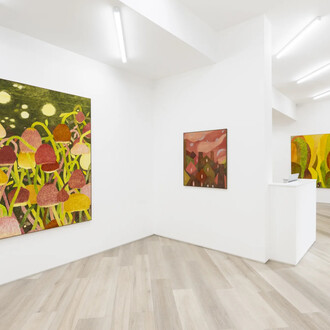Beers is pleased to present Objects for Rebels & Lovers, the first solo exhibition by Australian artist Clinton Hayden, presenting the artist’s multi-disciplinary practice and unique method of working, in which the artist acts as archivist, documentarian, storyteller, and librarian. Investigating themes of desire, intimacy and longing, Hayden’s practice incorporates a method of working through repetition, note-making, and a type of comprehensive image-making which builds immersive, serial, and analogue idea sites for the exploration of ideas. Throughout, Hayden cleverly plays with the tension between image and object as well as the interplay between context and form.
Primarily interested in exploring the Romantic notion of love and its antagonizing forces, Hayden is equally interested in ideas that rebel and repel, an approach that is heavily embedded here through Hayden’s interest in duende*, an idea that strongly permeates Hayden’s work, which he likens to the visual equivalent of the torch song. It is through this certain juxtaposition that Hayden forges to locate aspects of beauty hidden within grotesque, banal, or even somewhat dangerous settings. In Your Weight On Mine?/Lover’s Noose, Hayden takes direct influence from Edith Piaf’s Lovers for a Day: a tale of two lovers who decide that if they can’t live together, they should die together. Reminiscent of the work of Felix Gonzalez-Torres, the piece is a simple cotton rope with a noose knot on both ends; here, the work is shown both as a photo and installation, suggesting Hayden’s almost archival tendencies: an obsessive desire to include and disclose instead of edit or omit. It is through this process that Hayden himself becomes a Romantic figure, acknowledged by the ultimately futile act of collection and display, like a lover harboring love-notes, Hayden himself recognizes the act as unrefined, intimate, perhaps somewhat tragically disordered, even rebellious.
Such an idea lends itself to another work, entitled Molotov for Nabokov - Objects of Sedition*, which anthropomorphises the idea of rebellion and focuses it into a personal - in fact, futile - act. The scroll in this piece, such a politically laden metaphor, becomes a vessel for personal minutae: a love letter, carefully stitched, placed like the clichéd message in a bottle - stitched so that that the implications in‘god’s wrath’ are somewhat forgotten. Such anarchic, bittersweet undertones continue to play throughout the exhibition. Yes, society is broken, but it is possible to find hope within it. Each piece offering a glimpse into the fragility of emotion in all of its complexities and invites the viewer to immerse him or herself within this state of flux. This exhibition then, explores the tragedy of romance; the beauty of rebellion and the futility of our own placement within it all.
Through the active, obsessive idea of making, Hayden elevates his own production and other found-objects to create new meaning through the display of the work: a certain elevation of material that comes with its selection. Throughout, a certain Aesthetic is created, one that we may never fully understand but that we use to reflect upon our own experiences and personal history. Ultimately what Hayden invites is an investigation - into the material, the idea and the result - inviting the viewer to reconsider the need for truth when faced with the complexities of one’s own experience.
*Duende (“having duende”) loosely means having soul, a heightened state of emotion, expression and authenticity; a sad hopefulness, the likes of which can be found in the dark sounds of love songs.
*Sedition any action, especially in speech or writing, promoting such discontent or rebellion; rebellious disorder.
















